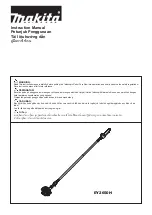
Service
►
Tool service must be performed only by qualified repair
personnel.
Service or maintenance performed by unqualified
personnel could result in a risk of injury.
►
When servicing a tool, use only identical replacement parts.
Use of unauthorized parts or failure to follow maintenance
instructions may create a risk of electric shock or injury.
Specific Safety Rules for Circular Saws
!
WARNING:
Risk of personal injury.
►
Keep hands away from the blade and cutting area.
Keep
your second hand on the auxiliary handle. If both hands
are holding the saw, they cannot be cut by the blade.
►
Keep your body positioned to either side of the saw
blade, but not in line with the saw blade.
Kickback could
cause the saw to jump backward. (See “Causes and
Prevention of Kickback” below.)
►
Do not reach underneath the workpiece.
The blade is
fully exposed under the workpiece.
4
ATF 55E Circular Saw
!
CAUTION:
Never use a dust extraction system when making
cuts that can result in sparks, such as cutting through
nails and other ferrous materials.
Sparks and hot embers
can cause a fire or explosion in the dust extraction system.
►
NEVER hold the piece being cut in your hands or across your
leg.
It is important to support the work properly to minimize
body exposure, blade binding, or loss of control.
►
Hold the saw by the insulated handles when performing an
operation in which the sawblade may contact hidden wiring or
its own cord.
Contact with a “live” wire will make the exposed
metal parts of the tool “live” and shock the operator.
►
When ripping, always use a rip fence or straight edge guide.
This improves the accuracy of cut and reduces the chance for
blade binding.
►
Always use blades with the correct size and shape (diamond vs.
round) arbor holes.
Blades that do not match the mounting
hardware of the saw will run eccentrically, causing loss of
control.
►
Never use damaged or incorrect blade flanges or bolt.
The blade
flanges and bolt were specially designed for your saw for
optimum performance and safety of operation.
Causes and Prevention of Kickback
Kickback is a sudden reaction to a pinched, bound, or misaligned saw
blade that causes an uncontrolled saw to lift up and out of the workpiece
toward the operator.
When the blade is pinched or bound tightly by the kerf closing down, the
blade stalls and the motor reaction drives the unit rapidly back toward
the operator.
If the blade becomes twisted or misaligned in the cut, the teeth at the
back edge of the blade can dig into the top surface of the wood, causing
the blade to climb out of the kerf and jump back toward the operator.
Kickback is the result of incorrect operating procedures or conditions
and can be avoided by taking proper precautions as described below:
►
Maintain a firm grip with both hands on the saw and position your
body and arm to allow you to resist kickback forces.
Kickback forces
can be controlled by the operator if proper precautions are taken.
►
If the blade is binding or when interrupting a cut for any reason,
release the trigger and hold the saw motionless in the material until
the blade comes to a complete stop.
Never attempt to remove the saw
from the work or pull the saw backward while the blade is in motion,
or kickback may occur. Investigate and take corrective actions to
eliminate the cause of blade binding.
►
When restarting a saw in the workpiece, center the saw blade in the
kerf and check that the saw teeth are not engaging the material.
If the
saw blade is binding during a restart, it may climb up or kickback from
the workpiece.
►
Do not use a dull or damaged blade.
Dull or improperly sharpened
blades cause excessive friction, blade binding, and kickback.
►
Support large panels to minimize the risk of the blade pinching and
causing a kickback.
Large panels tend to sag under their own weight.
Supports must be placed under the panel on both sides,
near the line of cut and near the edge of the panel as
shown.
►
The bevel adjusting knobs must be fully tightened before
making a cut.
If the blade tilts during a cut, it will bind and
cause a kickback.
►
Use extra caution when making a plunge cut into existing
walls or other blind areas.
The protruding blade may cut
objects that can cause kickback.
Respiratory Exposure Warning
!
WARNING:
Various dust created by power sanding, sawing,
grinding, drilling and other construction activities contains
chemicals known (to the State of California) to cause cancer, birth
defects or other reproductive harm. Some examples of these
chemicals are:
►
lead from lead-based paints,
►
crystalline silica from bricks and cement and other masonry
products, and
►
arsenic and chromium from chemically-treated lumber.
The risk from these exposures varies, depending on how often you
do this type of work. To reduce your exposure to these chemicals:
work in a well ventilated area, and work with approved safety
equipment, such as dust masks that are specially designed to filter
out microscopic particles.





































